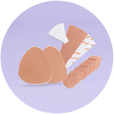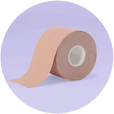In women's fashion, nipple covers and pasties have become go-to accessories. They prevent nip slips, awkward moments with tight or sheer clothing, and chafing during physical activities. They're convenient, discreet, and reliable, and some, such as silicone nipple covers, are even reusable.
But you might be asking whether they are bad for you. Let's explore the pros and cons of nipple covers and their potential impact on your health.
What Are Nipple Covers?
Nipple concealers, also called nipple covers or pasties, are adhesive accessories that hide your nipples. Primarily used by women, these small patches adapt to various outfits and aesthetics, preventing nipple protrusion or visibility through tight or sheer clothes.
Different Types and Their Uses
Disposable nipple covers are designed for single use, while reusable silicone covers are suitable for multiple uses. Nipple pasties sometimes serve decorative purposes, and unique designs are popular among lingerie wearers and burlesque dancers.
Nipple covers are highly versatile and suitable for various outfits and settings. They can be worn with bras, tricky necklines, sheer fabrics, or swimsuits, making them ideal for numerous occasions.
Gender Inclusivity
Nipple covers are not limited to women. Men also use them to prevent chafing during physical activities or to avoid nipple visibility under sheer clothing.

Market Availability
Nipple covers are widely available in physical stores like lingerie shops, department stores, and pharmacies, as well as on e-commerce platforms and brand websites.
Solutions for Sensitive Skin
Sensitive skin can pose a challenge when deciding on the right nipple covers. Fabric nipple covers serve a remedial purpose for women with sensitive skin. Composed of soft, reusable fabric, these covers safeguard the delicate skin around the nipples from chafing and irritation. Hypoallergenic materials like silicone or fabric blends minimize skin irritation. Always ensure the skin is clean and dry before application.
Benefits of Using Nipple Covers
- The suitable nipple covers create a smooth, seamless look underneath your clothing, making them ideal for tank tops, sports bras, or tight-fitting apparel.
- They reduce chafing and irritation as a barrier against harsh fabrics if you have sensitive skin.
- They prevent nipple show-through, which can occur in cold weather or with tight clothing.
- Nipple covers come in various styles, shapes, and colors.
- They're simple to use, making it easy to enhance the appearance of your breasts.
Safety Considerations
While many women find nipple covers essential, specific health considerations need careful attention.
- One primary concern might be skin irritation from adhesive nipple covers, especially for sensitive skin. Using hypoallergenic nipple covers might help reduce your chances of allergic reactions. If irritation occurs, discontinue their use.
- Quality and breathable nipple covers, particularly those made of silicone or fabric, minimize the risk of blocked pores and skin irritation. This is especially important during physical activities when sweat can accumulate under your covers.
- The adhesives in most nipple covers might cause dryness or reactions. Follow the manufacturer's instructions for their application and removal. Alternating adhesive types or rotating between several varieties might alleviate this issue.
Is there a connection between nipple covers and cancer?
There is no scientific evidence linking nipple covers to breast cancer. Women should continue to follow regular breast health practices like mammograms and self-examinations.
Safe Practices for Using Nipple Covers
Not all materials are equal regarding comfort and safety for nipple covers. Silicone ones offer a great fit but might not be the best option if you're prone to sweating or have sensitive skin. Fabric ones, generally made from cotton or soft lace, provide breathability. For sensitive skin, hypoallergenic nipple covers are a wiser choice.

How to Properly Apply and Remove Nipple Covers
Before applying your covers, clean and dry the area around your nipples. Avoid lotions or oils, as these could render the adhesive less effective. Position the cover without wrinkling to ensure smooth adhesion and remove them gently after use to prevent skin irritation.
Caring for Your Nipple Covers
Wash your reusable nipple covers with warm water and mild soap, then air-dry them to maintain their adhesive quality. Cleaning your nipple covers after every use is essential. Proper storage is also necessary to prolong their lifespan.
When to Replace Your Nipple Covers
If you care for silicone nipple covers properly, you can reuse them multiple times. In contrast, fabric nipple covers vary depending on the brand. Reduced stickiness and skin irritation are signs you need to replace your nipple covers.
Frequently Asked Questions
What are the downsides of using nipple covers?
Nipple covers can cause skin irritation and allergic reactions due to their adhesive materials if you have sensitive skin or wear them for a prolonged period. They also require proper maintenance and cleaning to ensure hygiene. Washing your skin with soap and water after each use and cleaning off any adhesive residues is essential for your skin's health.
Are there risks associated with wearing nipple covers daily?
As with adhesive bras, avoid wearing nipple covers for more than 8 hours daily to prevent potential irritation and discomfort.
What is the recommended duration for keeping the nipple covers on?
While it depends on the type and material, it's generally advisable not to wear them continuously for more than several hours to prevent discomfort and potential skin issues.






0 komentar